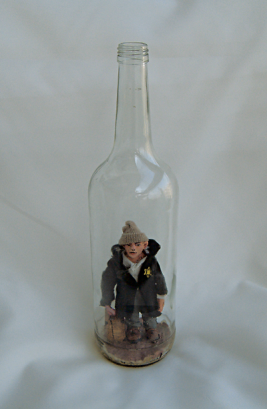| Revista Umělec 2003/2 >> Jiří Franta | Lista de todas las ediciones | ||||||||||||
|
|||||||||||||
Jiří FrantaRevista Umělec 2003/201.02.2003 Jiří Ptáček | new faces | en cs |
|||||||||||||
|
Born in 1978, since 2000 he has studied at the Academy of Fine Arts in Prague (currently in the studio of Vladimír Skrepl).
As is the custom in the most liberal atelier of the AFA in Prague, Jiří Franta also has no problem swapping media. Franta — who approaches with chutzpah the delicate topics of violence, historical memory and the abuse of power — was accepted in 2000 as a member of Rafani, a local art group which attempts to penetrate under the surface of society. And as Rafani has never renounced individual creativity, he is certain to extend himself even further in the future. Since 1999, Franta has been putting together a photographic cycle representing collectives, with all his people in his photos wearing terrorist masks. Among his first prints was a portrayal of the philharmonic orchestra, all posing wearing black ski masks. Unfortunately a project was done at the same time in New York by the Kosovan artist Sisley Xhafa, who became famous for his photo and Franta was left with the undeserved title of epigone. However Franta’s projects have an additional significance: They are constantly searching for new representatives of uniformed communities in which the personality is incorporated into the theme. Anyway, all collectives are carriers of ideas and models of behavior which, in direct proportion to their psychic eccentricity and their public display of power, may become dangerous to the rest of society. Franta radicalizes this position in an ironic commentary on today’s political challenges. In general with Jiří Franta it’s not possible to separate the black humor from the exploration of the limited reach of insufficient judgements on the past and the present. Figures of hanged men, a concentration camp prisoner and Jewish children with their luggage all inside a bottle schizophrenically attract attention, not only to the story that they symbolize, but also to the curious process by which it is at all possible to cram the figures into the bottle. Black monochrome drawings also show, even from a side view, that they actually present a grotesque tableau of violence committed by man. This is a sarcastic commentary on ultra-rightwing skinheads, and what’s more, the work approaches the circle of topics Rafani most often deal in. Currently, however, space is being established for reflection on the distance between esthetics and everyday reality. Another of Franta’s executions is connected to consequences. By setting up a street lamp directly above the surface of one Prague access road, he tried to create the intimate atmosphere of a domestic lamp in the public outdoors. Even though it was only for one day, the lamp belonged to an experiment carried out to try to “rename” the climate of a specific place through a simple stroke. Also excellent is his VW beetle carved out of bread and emerging from the other half of the loaf, a combination of Michelangelo’s mining of forms and Kinder Surprise eggs. This illustration lightens the advance from form-lessness to form, even when connected with two icons from a simple human life. In all that he does, Jiří Franta is always a capable painter, though it may seem at times that his pictures could lie with other works in the upsurge of noncommittal post-Pop drawings by young Czech academics. If his paintings have a gratuitous point and a contemporary tendency toward its ironization, they remain among the best.
01.02.2003
Artículos recomendados
|
|||||||||||||











Comentarios
Actualmente no hay comentariosAgregar nuevo comentario